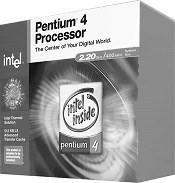Building Your Own PC-Processor
Both Intel and AMD sell processors through two primary channels or methods. They are referred to as boxed and OEM. A boxed processor and an OEM processor might have the same specifications, but they are packaged differently, include different supplemental components, and have different warranties.
Even though the boxed processors are sometimes also called retail processors, they are technically not intended to be sold in the normal retail channel. Both boxed and OEM processors are technically wholesale items and, as such, can be purchased from Intel or AMD only by signing up as a dealer with them and meeting their requirements to achieve and maintain dealer status.
After you are registered as an Intel or AMD dealer, you can purchase boxed processors directly from them. OEM processors are sold only to major accounts that purchase hundreds of chips at a time. Although neither the boxed nor OEM processors are intended to be sold in the retail channel.
After Intel or AMD sells them to one of their dealers, that dealer is free to resell the chips as he chooses. Therefore, an individual can purchase either boxed or OEM processors from many sources. The most obvious difference between the boxed and OEM processors is the physical packaging.
It could be argued that both technically come in boxes, but the Intel or AMD boxed processors come individually packaged in a colorful shrink-wrapped box that includes the processor, the heatsink and fan, installation instructions, a certificate of authenticity, warranty paperwork, as well as an "Intel inside" or "AMD instead" sticker that is supposed to be affixed to the front of the system chassis.

On the other hand, OEM processors come in a much larger box with 10 trays containing 10 processors each, or 100 processors in total. No heatsinks, fans, installation instructions, warranties, or other paperwork are included.
These are purchased in large quantities by the major system manufacturers. A boxed processor generally includes a 3-year warranty direct with the processor manufacturer. So, if the chip fails within 3 years of purchase, the end user can contact Intel or AMD directly and they will replace the chip. OEM processors have no warranty with the manufacturer (Intel or AMD).
However, the company from which you purchased it will likely offer a 30- or 90-day warranty. The warranty length and the way in which it is administered are entirely up to the dealer from which you purchased the chip, which could be a problem if, for example, that dealer has gone out of business.
Boxed processors also include a high-quality, manufacturer-supplied heatsink and cooling fan. Typically, the cooling system provided with a boxed processor is designed to work under worst-case thermal environments and is a very high-quality and heavy-duty unit.
When you think about it, it wouldn't serve Intel or AMD to provide cheap heatsinks and fans on a processor they are warranting for 3 years! OEM processors, on the other hand, include no heatsink or fan, but the dealer from which you purchase the processor will likely provide one.
Unfortunately, these are often of very uneven quality and performance, up to the whims of the particular dealer you are using. With only a 30-or 90-day warranty, it doesn't matter as much if the manufacturer skimps on the heatsink because, if the chip fails beyond the short warranty period, the company isn't obligated to replace it.
If you purchase an OEM processor with a motherboard, most dealers install the processor into the motherboard and provide a single warranty covering both items. The motherboards you consider should have one of the following processor sockets or slots:
-
Socket 478. Supports the second-generation Intel Pentium 4 processors
-
Socket 754. Supports the Athlon 64 processors
-
Socket A. Supports the AMD Athlon, Athlon XP, and Duron processors
The following slot and socket types also can be purchased but are not compatible with the latest CPU models and will limit your future processor upgrade options:
-
Socket 370 (also called PGA370). Supports the socketed versions of the Intel Pentium III and Celeron processors
-
Socket 423. Supports the initial versions of the Intel Pentium 4 processor but not current versions
-
Slot 1 (also called SC-242). Supports the slot versions of the Intel Pentium III, Celeron, and Pentium II processors
-
Slot A. Supports the original AMD Athlon processors
-
Socket 7 (also called Super7 if faster than 66MHz). Supports the Intel Pentium; Pentium MMX; AMD K5, K6, K6-2, and K6-3; Cyrix 6x86 and 6x86MX; and MII processors
Because the motherboard you choose dictates or limits your choice in processor, you should choose your processor first. These days, the choice of processors runs the gamut from the Intel Celeron on the low end to the AMD Athlon XP, Athlon 64, and Intel Pentium 4 on the high end.
Depending on the type of motherboard you select, there might be jumpers on the motherboard to set for processor type and speed. It also might have jumpers to control the voltage supplied to the processor. Typically, older Socket 7 or Super7 boards have jumpers for motherboard bus speed, CPU multiplier, and CPU voltage settings.
If you purchase this type of board, be sure you get these settings correct; otherwise, the system won't run properly. In a worst-case situation, you can damage the processor with too high a voltage setting, for example. All modern processor sockets handle these settings automatically, so there is little danger of incorrect settings.
Even so, several boards have overrides for the automatic settings, which can be useful for those intending to hotrod or overclock their processors. Most of these boards use the BIOS Setup to control these overrides, so no jumpers or switches need to be set.